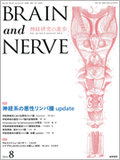Japanese
English
- 有料閲覧
- Abstract 文献概要
- 1ページ目 Look Inside
- 参考文献 Reference
中枢神経系原発悪性リンパ腫(PCNSL)は,日本のリンパ系腫瘍の約1~2%を占める稀な疾患である。PCNSLは血液脳関門により隔てられたいわゆるchemotherapeutic sanctuariesに発生する。PCNSLに対する1つの標準療法はメトトレキサートおよびシタラビン大量療法で寛解導入後,全脳照射(WBRT)で地固め療法を行う化学放射線療法で,わが国でも約30~40%の症例で長期生存が得られるようになった。さらなる生命予後の改善とWBRTによる毒性の回避がPCNSL治療における現在の主要な課題である。自家幹細胞移植を併用しアルキル化薬などの投与量を増加させることや抗CD20抗体など分子標的治療の導入が,WBRTの毒性を回避する治療法として試みられている。
Abstract
Primary central nervous system lymphoma (PCNSL) is a rare, aggressive form of lymphoma, accounting for approximately 1-2% of all cases of lymphoid neoplasms in Japan. The current standard treatment for these tumors, which arise in pharmacological sanctuaries isolated by the blood brain barrier, is chemo-radiation with high-dose methotrexate (3g/m2) and cytarabine (3g/m2) followed by whole brain radiotherapy (WBRT) (45Gy). To overcome the limitations of and neurotoxicities associated with WBRT, several novel therapeutic strategies have been developed. These include either upfront intensive chemotherapy with high-dose alkylating agents combined with stem cell transplantation or less toxic immunochemotherapy with molecular targeted agents such as anti-CD20 monoclonal antibody. The roles of these therapies for PCNSL are being assessed in ongoing randomized clinical trials and will be further explored in the future.

Copyright © 2014, Igaku-Shoin Ltd. All rights reserved.


